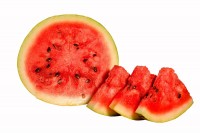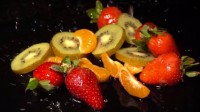Fructose
There is practically a catastrophe with fructose damaging done to liver and kidneys.
Nonalcoholic fatty liver disease (NAFLD) takin over population by storm. Including young adults in their twenties.
http://www.bristol.ac.uk/alspac/news/2019/non-alcoholic-fatty-liver-disease.html
"Speaking of fruit, fructose is one of the leading causes of kidney failure, one that you and your doctor, even your nephrologist, are almost certainly unaware of. Fructose is such a toxin that 60 percent of it is shunted toward the liver, where it is converted to the form of fat called triglycerides (which causes heart disease) and to uric acid, which raises blood pressure, causes gout, and directly damages your kidneys filtration system.6 Thirty percent of fructose that you consume doesn’t go to your liver but heads right to your kidneys, where it causes a more direct insult to their filtering system.7"
The Plant Paradox. Dr. Steven R. Gundry, M.D. This material may be protected by copyright.
6. Gersch et al. 2007. Fructose, but not dextrose, accelerates the progression of chronic kidney disease. American Journal of Physiology. Renal Physiology 293(4): F1256-F1261.
7. Johnson et al. 2010. The effect of fructose on renal biology and disease. Journal of the American Society of Nephrology 21(12): 2036–2039.
2/3 of Americans have none-alcohol related fatty liver. Scary statistics...
"Fructose is processed differently than glucose, bypassing your bloodstream and hopping on the express train to your liver. Dr. Lustig calls the unique effect of fructose on our biology "isocaloric, but not isometabolic" (the iso prefix signifies "same").Whatthismeansisthatthough
it has an equal number of calories, gram for gram, as other sugars, fructose seems to behave in a rather peculiar manner from the perspective of your metabolism. It doesn’t elevate blood sugar and doesn’t cause a rise ininsulin—atleastnotinitially.Foodcompaniescommonlyexploit
this difference to sell products sweetened with fructose to health-conscious consumers and diabetics. Once in the liver, fructose induces lipogenesis—literally, fat creation. In truth, all carbohydrateswhenconsumed inexcessarecapableofstimulatinglipogenesis,
but fructose may be the most efficient at doing so. One short-term study published in the journal Obesity demonstrated nearly double the increasein liver fat when healthy humans on high-caloriedietssupplemented withfructose comparedto glucose(113 percent
versus 59 percent, respectively).21"
While fructose has a negligible immediate effect on blood sugar, frequent consumption will eventually cause blood sugar to rise because the stress on the liver creates inflammation, impairing the ability of cells to "suck up" glucose from the blood. This may have been an adaptation to help us store more fat when fruit was in season, and yet now explains why sugar consumption dovetails with skyrocketing rates of type 2 diabetes. (Now is probably a good time to question whether fructose-dominant sweeteners like agave syrup—90 percent fructose—are really the right choice for health-conscious individuals or diabetics.)"
"The combined effects of fructose may add up to altered gene expression in the brain. In a study out of UCLA, rats were given the amount of fructose equivalent to drinking a one-liter bottle of soda every day.22 After six weeks, they began to show typical derangements: they had escalating levels of blood sugar, triglycerides, and insulin, and their cognition began to break down. Compared to mice fed only water, the fructose-drinking mice took double the time to find their way out of a maze. But what surprisedthe researchers most was that close to one thousand genes in the brains of the fructose-fed rats were altered. These weren’t genes for cute pink noses and fuzzy whiskers—they were comparable to genes in humans, having links to Parkinson’sdisease, depression, bipolar disorder, and others. The degree of gene disruption was so profound, head researcher Fernando Gomez-Pinilla commented in the UCLA release: "Food is like a pharmaceutical compound" in terms of its effect on the brain. But that power also swings in the other direction—the negative impact that fructose had on both cognition and gene expression was attenuated by feeding the rats DHA "omega-3 fat.
Avoiding the stresses imposed on the brain by excess sugar consumption may be an empowering leverage point for the 5.3 million Americans suffering from traumatic brain injury. A diet high in fructose impaired the plasticity of rat brains, diminishing the irability to heal after head trauma. Though rats are not people, brain injury is a fairly organic condition that is easily replicable in animals—unlike, say, a complex human disease that rats and mice do not naturally develop."
Excerpts From Genius Foods by Max Lugavere
This material may be protected by copyright.
- "Before 2006, it was largely unknown that children were experiencing fatty liver disease; further study revealed fructose, a trigger for nonalcoholic fatty liver disease (NAFLD), passes through breast milk.
- Globally, 25% of adults have NAFLD; up to 45% of Hispanics have it, potentially related to a genetic variant
- An interventional study is now in clinical trials enrolling children with the genetic variant who consume high amounts of sugar to assess whether reducing fructose and sugar intake will reduce NAFLD incidence
- The health risks of NAFLD are exacerbated by excess fructose — commonly found in sweetened beverages and most processed foods — choline deficiency, poor weight management, Type 2 diabetes and lack of exercise
- You may support your liver health by maintaining a healthy weight, exercising regularly, limiting medications, managing your blood pressure and improving your insulin sensitivity."
Avoid fructose.
Aside from raising your insulin, fructose also elevates uric acid, which drives up your blood pressure by inhibiting nitric oxide in your blood vessels. (Uric acid is actually a byproduct of fructose metabolism. In fact, fructose typically generates uric acid within minutes of ingestion.)
If you're healthy and want to stay that way, the general rule is to keep your total fructose intake to 25 grams per day or less. If you're insulin resistant and/or have high blood pressure, keep your total fructose to 15 grams or less per day until your condition has resolved.
Juice. Hidden dangers
Are Fruit Juices Just as Unhealthy as Sugar-Sweetened Beverages?
References:
https://jamanetwork.com/journals/jamanetworkopen/fullarticle/2733417


